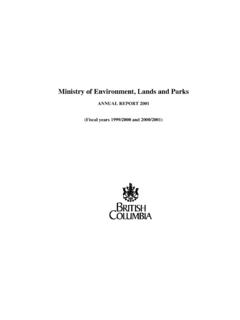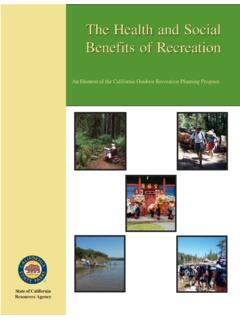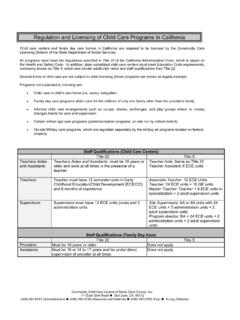Transcription of Seral Stages across Forested Landscapes: Relationships to ...
1 EEEEE xtenxtenxtenxtenxtensssssionionionionion NoteNoteNoteNoteNote18 Ministry of Forests Research ProgramMinistry contacts:H. Karen Yearsley andJohn Ministry of ForestsResearch Box 9519 Stn Prov GovtVictoria, BC V8W 9C2(250) 387-6721 April 1998 BiodiversityManagement Conceptsin Landscape EcologyIntroductionVarious plants and animals rely ondifferent forest ecosystem Stages tomeet their habitat needs. Grizzlybears, for example, can range overhundreds of square kilometres insearch of the food resources availablein open and young forests before hi-bernating deep in mature plant species can only developon open, treeless, freshly disturbedsites, while certain canopy-dwellinginsects spend their entire lifetime onthe broad lichen- and moss-coveredlimbs of a single ancient spruce.
2 Dur-ing spring and summer, deer maysample tender herbs in clearcut areas,but, in severe winters, retreat severalkilometres to protective and the ecosystems thatcompose them age through process of forest aging called succession transforms the composi-tion of Forested ecosystems as bioticcommunities respond to and modifytheir environment. Succession is animportant topic in landscape ecologybecause of its significant effects onlandscape diversity and the subse-quent biological diversity andviability of various plant and Forest Practices Code acknowl-edges the importance of landscapeecology concepts by enabling districtmanagers to designate planning areascalled landscape units, each with spe-cific landscape unit objectives.
3 TheBiodiversity Guidebook ( Ministryof Forests and Ministry of Envi-ronment, Lands and Parks ), acomponent of the Code, recommendsprocedures to maintain biodiversity atboth the landscape and the stand approach, which uses principlesof ecosystem management temperedby social considerations, recognizesthat the habitat needs of most forestand range organisms are met if abroad range of forest stand ages( Seral Stages ) are maintained extension note is the seventhin a series designed to raise awarenessof landscape ecology concepts and toprovide background for the ecologi-cally based forest management ap-proach recommended in theBiodiversity Guidebook.
4 The focus hereis on Seral Stages . We first define suc-cession and Seral Stages . We then dis-cuss the evolving views of ecosystemdynamics and succession theory, therole of disturbances in the currentgeneral model of forest development,and the influence of different seralstages on biodiversity. We conclude bysuggesting how these concepts can beapplied in landscape-level planningfor Stages across Forested Landscapes: Relationships to Biodiversity part of .. the habitat needs ofmost forest and rangeorganisms are met if abroad range of forest standages or Seral Stages aremaintained acrosslandscapes .. January 2000.
5 Policy direction for biodiversity is now represented by the Landscape Unit PlanningGuide. This Extension Note should be regarded as technical background only. Seral Stages and Succession:DefinitionIn ecological terms, a sere is theseries of biotic communities formedby the process of ecosystem develop-ment called succession. In forestedlandscapes, the various vegetationcommunities that occupy disturbedsites and make up a sere are called Seral Stages . Seral - stage communitiesconsist of vegetation types that areadapted to the site s particular set ofphysical and biotic conditions. In theunmanaged Forested landscape, vari-ous natural disturbance agents (suchas fire, windthrow, landslides, andinsects) are responsible for creatingforests containing a full range ofstand example, a Forested landscapethat has experienced a severe fire doesnot recover to its former state in onestep.
6 Instead, various types of vegeta-tion will supplant each other overtime on the burnt-over lands. In thisprocess, some components of thephysical environment are altered,which influences the conditions forsubsequent plant communities. Ini-tially, species adapted to more exposedconditions will colonize the disturbedsites. These species create shade andinfluence the soil conditions by add-ing organic material as their leaves,stems, and roots decay. This producesfavourable conditions for the nextseral community of young coniferoustrees and deciduous shrubs and trees,which displace the process of succession is notrestricted to plant communities.
7 Italso occurs at the ecosystem levelwithin animal and microbial commu-nities. These communities can experi-ence sequential changes that areconcurrent with vegetative seralstages. Seral Stages can therefore bedefined to include microclimate, soil,vegetation, animal, and microbialcomponents (Kimmins ).Although the word stage impliesa simple linear sequence, contem-porary ecological theory does notfigure Generalized curves of change in ecosystem attributes with long recovery periodsafter disturbance in old-growth Douglas-fir forests. These curves were developed forDouglas-fir forests; however, the patterns are expected to apply to other forest typesin British Columbia, although the age scale will vary among forest types (adaptedfrom Spies and Franklin 1988).
8 HighLowCurve 1 Curve 2 YoungOld growthAncientArbitrary scaleMatureStand age (years)IE050100200300400500600tab le Classification of ecosys-tem characteristics according totheir expected pattern of changeduring succession in Douglas-firforests (from Spies and Franklin1988).Characteristics following a U-shaped curve (Curve 1)Amount of coarse woody debrisNumber of large snagsCWD as percentage of totalecosystem biomassHeterogeneity of understoreyPlant species diversityMammal diversityCharacteristics following an S-shaped curve (Curve 2)Average tree sizeDiversity of tree sizesIncidence of broken topsForest floor depthSurface area of boles andbranchesWood biomass view succession as a predictable proc-ess where distinct assemblages ofvegetation replace one another at eachstage until an obvious end point isreached.
9 Instead, succession can beviewed as a cyclical continuum whereseral Stages often overlap. For exam-ple, because the temporal distributionof species is highly variable, someplants are present throughout thiscycle, while others appear only forshort periods when specific conditionsoccur. However, the idea of seralstages continues to be a useful con-ceptual Stages and Succession:Ecological PrinciplesChanging views of ecosystemdynamicsLike the landscapes and ecosystemsthey attempt to describe, theories ofsuccession also evolve. Early in thiscentury, Clements theory of suc-cession presumed that plant commu-nities moved through an orderly,directional, and non-random processof change in species composition overtime.
10 This process was determined byregional climate and resulted in astable, climax community where fur-ther changes were inconsequential(Spies ).This theory supported the prevail-ing view that environments wereessentially homogeneous and thatnatural systems such as forests were closed to outside influences. A stateof ecological balance existed withinforested communities. Genetic, spe-cies, and ecosystem diversity remainedrelatively stable, but changed gradu-ally through natural , environmental fluctuationswere not important and natural dis-turbances played no role in plantsuccession. This steady-state equilib-rium model mirrored the popularconcept of the balance of nature (Parminter ).









